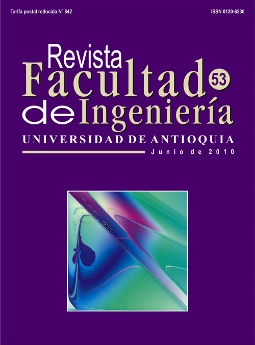Topology effect of two PSO and simplex hybrids
Keywords:
optimization, particle swarm optimization, simplex, hybridsAbstract
This paper shows optimization results for a group of standard functions. When the optimization algorithm PSO is hybridized with the simplex traditional algorithm (SX, Nelder-Mead) in two different ways, i. e. thealternating interaction hybrid (PSOSX(AIH)) and the parametric evolution hybrid (PSOSX(PEH)), markedly noticeable effects are observed in both the computing time and the accuracy and precision of their results during the optimization process.
Downloads
References
F. Chan, M. Kumar. “Swarm intelligence”. Focus on ant and particle swarm optimization. Ed. I-Tech Education and Publishing. Vienna. Chap. 7. 2007. pp. 111-139.
F. Van den Berg. An analysis of particle swarm optimizers. Ph.D. Thesis. University of Pretoria. Pretoria. 2002. pp. 1-135.
A. Moraglio, C. Di Chio, J. Togelius, R. Poli. “Geometric Particle Optimization”, J. of artificial Evolution and Applications. Vol. 1. 2008. pp. 1-14.
T. Havens, C. Spain, N. Salmon, J. Keller. “Roach Infestation Optimization”. IEEE Swarm Intelligence Symposium. St. Louis (MO). 2008. pp. 21-23.
A. Carlisle. Applying the particle swarm optimizer to non-stationary environments. Ph.D. Thesis. Auburn University. Auburn (USA). 2002. pp. 1-120.
J. Nanbo. Particle swarm optimization in engineering electromagnetic. Ph.D. Thesis. University of California. Los Ángeles (CA). 2008. pp. 1-135.
K. Byung. Parallel algorithms for biomedical optimization problems. Ph.D.Thesis. University of Florida. Gainesville (FL). 2005. pp. 1-167.
M. Clerc. Particle Swarm Optimization Ed. Prentice Hall. Chippenham (Great Britain). Chapter 4. 2006. pp. 69-79.
J. Kennedy, R. Eberhart. “Particle Swarm Optimization”. Proc. IEEE Int. Conf. Neural Networks. Piscataway (USA). 1995. pp. 1942-1948.
http://proquest.umi.com/pqdweb. Databases ProQuestMR. Consultado el 8 de mayo de 2009.
A. Lazinica. Particle Swarm Optimization, Ed. In- Tech. Vienna (Austria). 2009. pp. 1-486.
J Nealder, R. Mead. “A Simplex method for function minimization”. Computer Journal. Vol.7.1965. pp. 308-313.
F. Chia, C. Hsu. “Temperature control by chip implemented adaptive recurrent fuzzy controller designed by evolutionary algorithm.” IEEE Transactions on circuits and systems. Vol. 52. 2005. pp. 2376-2384.
S. Shu-Kai, E. Zhara. “A hybrid simplex search and particle swarm optimization for unconstrained optimization”. Euro. J. of Operational Research. Vol. 2. 2007. pp. 527-548.
Downloads
Published
How to Cite
Issue
Section
License
Copyright (c) 2018 Revista Facultad de Ingeniería

This work is licensed under a Creative Commons Attribution-NonCommercial-ShareAlike 4.0 International License.
Revista Facultad de Ingeniería, Universidad de Antioquia is licensed under the Creative Commons Attribution BY-NC-SA 4.0 license. https://creativecommons.org/licenses/by-nc-sa/4.0/deed.en
You are free to:
Share — copy and redistribute the material in any medium or format
Adapt — remix, transform, and build upon the material
Under the following terms:
Attribution — You must give appropriate credit, provide a link to the license, and indicate if changes were made. You may do so in any reasonable manner, but not in any way that suggests the licensor endorses you or your use.
NonCommercial — You may not use the material for commercial purposes.
ShareAlike — If you remix, transform, or build upon the material, you must distribute your contributions under the same license as the original.
The material published in the journal can be distributed, copied and exhibited by third parties if the respective credits are given to the journal. No commercial benefit can be obtained and derivative works must be under the same license terms as the original work.






 Twitter
Twitter